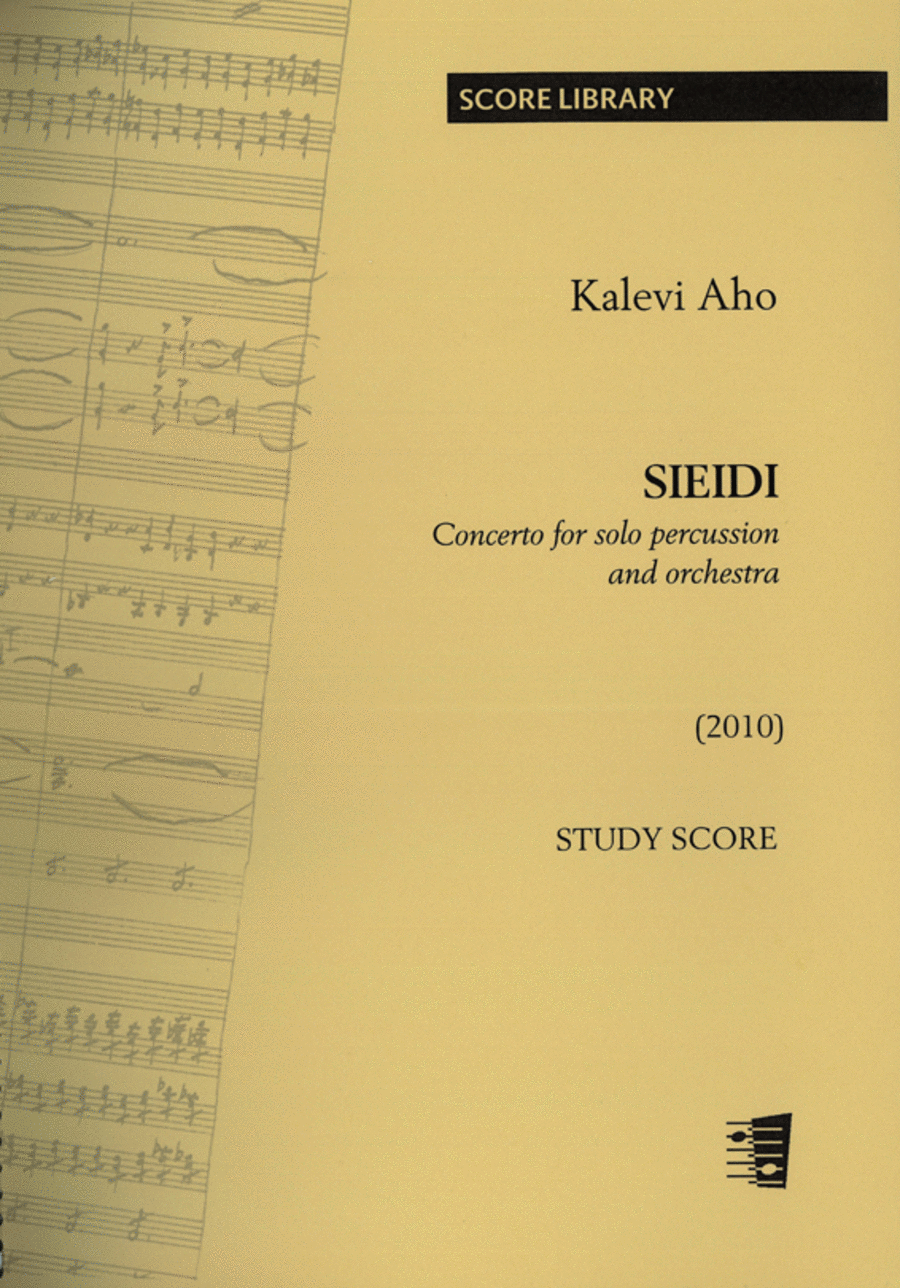Orchestra
SKU: FG.55011-315-2
Composed by Kalevi Aho. Study score. Fennica Gehrman #55011-315-2. Published by Fennica Gehrman (FG.55011-315-2).
ISBN 9790550113152.
The Sieidi concerto is in one movement but divided into several sections both faster and slower, wildly rhythmic, lyrical and more static. For the soloist it is extremely demanding because he is constantly having to switch from one technique to another - for djembe and darabuka playing with the hands differs radically from that of tom-tom or drumstick technique or the playing of pitched percussion instruments such as the marimba and vibraphone.
Normally, in a percussion concerto, the soloist has to play surrounded by a huge battery of instruments, often behind the orchestra. In Sieidi he uses only nine instruments, and he is in front of the orchestra the whole time. The instruments are in a row in front of the platform, starting with the djembe on the far right (as viewed by the audience) and ending with the tam-tam on the far left. The soloist plays only one instrument at a time.
The title of the concerto, Sieidi, is Sami - a language spoken in the northern region of Finland, Sweden and Norway known as Lapland. It denotes an ancient cult place such as an unusually-shaped rock, sometimes also a special rock face or even a whole mountain fell.
The Sieidi concerto is in one movement but divided into several sections both faster and slower, wildly rhythmic, lyrical and more static. For the soloist it is extremely demanding because he is constantly having to switch from one technique to another - for djembe and darabuka playing with the hands differs radically from that of tom-tom or drumstick technique or the playing of pitched percussion instruments such as the marimba and vibraphone.
Normally, in a percussion concerto, the soloist has to play surrounded by a huge battery of instruments, often behind the orchestra. In Sieidi he uses only nine instruments, and he is in front of the orchestra the whole time. The instruments are in a row in front of the platform, starting with the djembe on the far right (as viewed by the audience) and ending with the tam-tam on the far left. The soloist plays only one instrument at a time.
The title of the concerto, Sieidi, is Sami - a language spoken in the northern region of Finland, Sweden and Norway known as Lapland. It denotes an ancient cult place such as an unusually-shaped rock, sometimes also a special rock face or even a whole mountain fell.
The Sieidi concerto is in one movement but divided into several sections both faster and slower, wildly rhythmic, lyrical and more static. For the soloist it is extremely demanding because he is constantly having to switch from one technique to another - for djembe and darabuka playing with the hands differs radically from that of tom-tom or drumstick technique or the playing of pitched percussion instruments such as the marimba and vibraphone.
Normally, in a percussion concerto, the soloist has to play surrounded by a huge battery of instruments, often behind the orchestra. In Sieidi he uses only nine instruments, and he is in front of the orchestra the whole time. The instruments are in a row in front of the platform, starting with the djembe on the far right (as viewed by the audience) and ending with the tam-tam on the far left. The soloist plays only one instrument at a time.
The title of the concerto, Sieidi, is Sami - a language spoken in the northern region of Finland, Sweden and Norway known as Lapland. It denotes an ancient cult place such as an unusually-shaped rock, sometimes also a special rock face or even a whole mountain fell.
The Sieidi concerto is in one movement but divided into several sections both faster and slower, wildly rhythmic, lyrical and more static. For the soloist it is extremely demanding because he is constantly having to switch from one technique to another - for djembe and darabuka playing with the hands differs radically from that of tom-tom or drumstick technique or the playing of pitched percussion instruments such as the marimba and vibraphone.
Normally, in a percussion concerto, the soloist has to play surrounded by a huge battery of instruments, often behind the orchestra. In Sieidi he uses only nine instruments, and he is in front of the orchestra the whole time. The instruments are in a row in front of the platform, starting with the djembe on the far right (as viewed by the audience) and ending with the tam-tam on the far left. The soloist plays only one instrument at a time.
The title of the concerto, Sieidi, is Sami - a language spoken in the northern region of Finland, Sweden and Norway known as Lapland. It denotes an ancient cult place such as an unusually-shaped rock, sometimes also a special rock face or even a whole mountain fell.
Arr : OrchestraPublisher : Fennica Gehrman$79.95 - See more - Buy online
 (AMERICAN COMPANY)
(AMERICAN COMPANY) 

